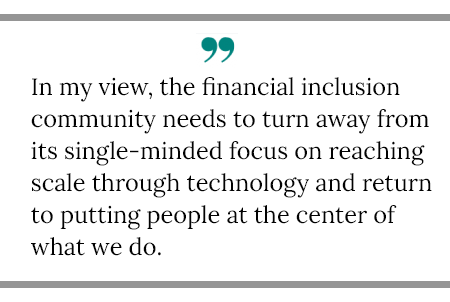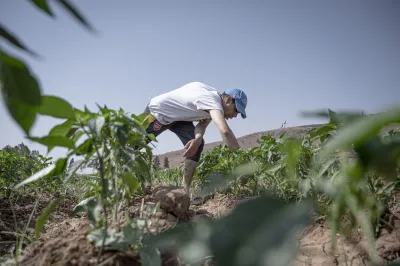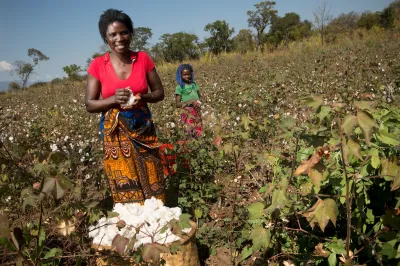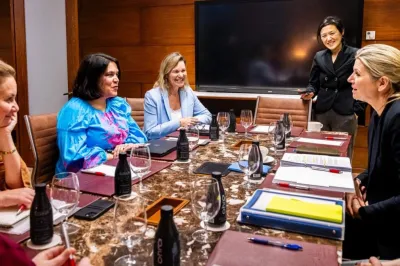Finding Opportunity in “Interesting Times”
What a year . . . 2020 was certainly one for the history books.
During a similarly turbulent period in 1966, Robert Kennedy spoke in Cape Town, South Africa, about the dynamism of times like these. In his speech, he remarked: “There is a Chinese curse which says: ‘May he live in interesting times.’ Like it or not we live in interesting times. They are times of danger and uncertainty; but they are also more open to the creative energy of men than any other time in history.”
Apart from the jarringly gendered language, it seems to me that Kennedy described 2020 to a tee. COVID-19, along with the racial, economic and political reckonings that have come in its wake, will impact the world in profound ways for many years to come. And in this shock to the system lies opportunity for change.
In our space of financial inclusion, there were three main takeaways for me from 2020.
First, it is clearer than ever that financial services have an important role to play in the lives of the poor. In developed and emerging economies alike, digital payment systems quickly got much-needed help into the hands of people in need. Credit sustained micro and small businesses, and savings provided a crucial lifeline to many households that had lost their livelihoods. Financial services matter, but they are also quite clearly a means to an end. And the end is people’s well-being, which has taken a huge hit from this crisis.

Second, it is quite clear that we are experiencing a rapid acceleration in the digitization of all aspects of our lives: how we work, how we study, how we shop and how we interact with loved ones, who for many of us seemed far away in this peculiar year. The “creative energy” that Kennedy spoke about is playing out in myriad ways in cyberspace, helping us manage through the pandemic and likely changing the way we live forever.
Finally, this year underscored for me the importance of government and the limitations of relying on technology or market mechanisms alone to solve complex problems. It took coordinated action across government and the private sector to get help to those in need. When governments failed in this endeavor, the consequences were catastrophic. The role of government has been dismissed and denigrated for decades in my country, starting with President Ronald Reagan, who said, “The nine most terrifying words in the English language are: I'm from the government and I'm here to help." Without the government being here to help in 2020, many people would have found themselves in desperate straits.
It is often overlooked that government plays a crucial role in building and regulating the technology that drives so much change in our lives. As Michael Lewis points out in “The Fifth Risk,” government-generated data powers virtually the entire business model of The Weather Channel. The m-RNA delivery mechanism that is behind both the Pfizer and Moderna coronavirus vaccines was conceived by scientists at the National Institutes of Health. The internet was born out of a project at the Defense Advanced Research Projects Agency (DARPA) to connect the military chain of command in the 1960s. And in the early 1990s, Tim Berners-Lee, a computer programmer working at CERN (the European Organization for Nuclear Research) created the protocols that gave us the world wide web. As much as we have billionaires in Silicon Valley to thank for the innovation that is driving our economies and reshaping our lives, much of their success was built on foundations of quiet innovation that took place inside government offices. And if 2020 showed us how much digital technology can improve lives, the opening weeks of 2021 also provided a chilling reminder of the harms arising from unfettered use of digital platforms for disseminating misinformation and hate.
CGAP has always believed in the transformational power of public goods and productive partnerships between the private and public sectors. The remarkable change taking place in India through the development of the India Stack evinces the power of such partnerships. And we will need an arsenal of private and public goods to tackle the challenges of poverty in the 21st century.
All of which brings me to the year ahead in financial inclusion.

In my view, the financial inclusion community needs to turn away from its single-minded focus on reaching scale through technology and return to putting people at the center of what we do. Technology can be a positive force for poverty reduction, but it must work to the benefit of people, and its negative impacts must be actively mitigated. Positive outcomes for people should be our guiding star, not the number of accounts that have been opened.
A year ago, I shared with CGAP’s readers that we would be shifting to an outcomes-based framework for financial inclusion, focusing on the ways financial services can help poor households to improve their lives by helping them to generate reliable incomes, gain access to essential services and protect themselves from downside risks. Importantly, we committed to putting women front and center in our work so that we could begin to address the persistent gender gap in financial inclusion. Our new framework has had profound implications for where we choose to place our attention. Rather than thinking about the ways to build better digital infrastructure to give people access to financial services, we have focused instead on how to use that infrastructure to get poor people the services they need to improve their lives in meaningful ways.
What does that look like in practice? Let me share two examples. It is clear that digital payment systems have been game changers in the pandemic response. Countries that have invested in payments infrastructure have been able to help people far more effectively than countries that have not. But the work doesn’t stop at building an ID system, a registry and a switch. It requires understanding the downstream dynamics of distribution, pricing and consumer choice, and pulling together public and private partners to deliver payments to those who need them. And by putting a gender lens on social welfare programming, resources land in the hands of women, where there is ample evidence of outsized benefits for families. CGAP’s work on distribution and G2P payments is designed to put people, especially women, at the center of the equation, not infrastructure.
Another example comes from the micro and small enterprise (MSE) finance space. The access and usage paradigm in financial inclusion held that scale mattered above all else and viewed technology as a way to deliver scale. Microfinance went out of fashion in part because payment systems were able to reach more people and the data that payment systems generated enabled the delivery of digital credit to low-income households at a breathtaking pace. But we can’t rebuild livelihoods on short-term consumer credit that is priced (charitably) at rates well in excess of 100 percent a year. Low-income households and informal microenterprises need access to productive credit to rebuild, and it is in shockingly short supply. They also need safe places to save. The microfinance industry provides both. But it took a hit in 2020, and I expect we will see waves of stress and consolidation in the industry in 2021. I am not suggesting that the microfinance industry does not need to modernize – it does. But it is all too easy to discard the microfinance industry if scale through technology is your primary goal.
In 2020, CGAP advanced its agenda on income generation by revisiting MSE finance, looking at rural and agricultural livelihoods in new ways and exploring the opportunities and risks that digital platforms present for informal workers. You will see more from us on these important topics in the coming months. We also started mainstreaming gender across all of our work, gathering evidence on how women interact with the platform economy, incorporating a gender lens into our work on distribution and exploring the ways in which G2P payments could offer women greater choice. In the coming year, we will build on this learning and will also start to define our work in the other two pillars of our new outcomes-based framework: access to essential services and resilience.
Last year was jarring for all of us, and we are not yet at the end of the COVID-19 crisis. But we are at the beginning of the end. The light that has accompanied us through the dark tunnel of COVID-19 is the promise of Robert Kennedy’s “creative energy.” I hope the energy arising from this crisis will help us to harness advances in technology to address the serious challenges this year has brought into sharp relief and build the kinds of public-private partnerships that will be needed to bring about lasting improvements in the lives of the poor.




Add new comment